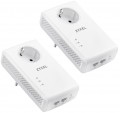Wired speed
The maximum wired speed supported by the adapter.
When choosing according to this indicator, note that manufacturers usually indicate the theoretical maximum in the specifications. In fact, the wired speed can be noticeably lower (in particular, due to interference in the mains). In addition, it may be limited by other factors: for example, if the adapter has only one 100 Mbps Fast Ethernet port, then its actual bandwidth cannot exceed 100 Mbps, even if the specifications indicate a wired speed of 500 Mbps .
Nevertheless, the higher the claimed speed (
1 Gbps), the higher the practical one, all other things being equal. So for tasks related to the transfer of large amounts of data or requiring a quick response (watching/broadcasting high-definition video, working with torrents, online games), you should choose the “faster” models.
LAN
The number of output connectors provided in the adapter design.
There are LAN ports with different bandwidth. So Fast Ethernet provides data transfer rates up to
100 Mbps ; such indicators are quite enough for most simple tasks and even for watching high-definition video in streaming mode. At the same time, as technology develops, this standard is gradually losing ground to the more advanced Gigabit Ethernet at speeds up to
1 Gbps. This option can be especially useful for transferring large amounts of information, as well as in cases where several network devices are connected to one port at once.
The presence
of several Ethernet connectors allows you to simultaneously connect several devices to the adapter (for example, a PC, a printer and a network TV) without the use of routers and other additional equipment. Also note that one set may include adapters with a different number of connectors. As a rule, in such cases, one device has 1 network port and works “at the input” (for example, an Ethernet cable from the provider is connected to it), the remaining adapters act as switches for several devices.
Wi-Fi standard
Wi-Fi standards supported by the adapter.
Wi-Fi technology allows you to use the adapter as a wireless access point for laptops, smartphones, tablets, etc. Also, many models are able to work in Wi-Fi clone mode, repeating the signal of a router already on the network and expanding its range. And different Wi-Fi standards differ in maximum data transfer rate and frequency range:
- — Wi-Fi 1 (802.11b). Has a theoretical maximum speed of 1 Mbps, uses a frequency of 2.4 GHz;
- — Wi-Fi 3 (802.11g) — speed up to 54 Mbps, frequency 2.4 GHz;
- — Wi-Fi 4 (802.11n) — speed up to 600 Mbps, frequency 2.4 GHz or 5 GHz;
- — Wi-Fi 5 (802.11ac) — speeds up to 6.77 Gbps, frequency 5 GHz.
- Wi-Fi 6 (802.11ax). A version with increased speed up to 10 Gbps and important improvements in the format of work. One of the most important innovations is the use of an extensive frequency range - from 1 to 7 GHz; this, in particular, allows you to automatically select the least loaded frequency band, which has a positive effect on the speed and reliability of the connection. At the same time, Wi-Fi 6 devices are capable of operating at the classic frequencies of 2.4 GHz and 5 GHz. In addition, some improvements were introduced in this version regarding the simultaneous operation of several devices on one channel, in particular, we are talking about OFDMA technology. Thanks to this, Wi-Fi 6 gives the smallest speed drop among m
...odern standards when the air is loaded.
Note that the data transfer rate is an perfect theoretical indicator; in fact, it is usually several times lower.
The described standards are mutually compatible if they coincide in operating frequencies (unless the speed of operation will be limited by the slowest device). Thus, the 802.11ac standard is practically not used in its pure form — it is supplemented at least with support for 802.11n.Frequency range
Wi-Fi frequency bands in which the adapter operates. This setting is directly related to supported Wi-Fi standards (see above). However, individual ranges have their own common features that are not dependent on standards.
-
2.4 GHz. The most popular band supported by both the latest and legacy wireless equipment. At the same time, this frequency is popular not only in Wi-Fi modules, but also in other devices (Bluetooth communication, microwave oven generators, etc.), which leads to quite a lot of interference and increases the likelihood of communication problems.
-
5 GHz. The 5 GHz band allows to achieve higher data rates than 2.4 GHz; in addition, it is less loaded with interference. Therefore, support for this frequency is increasingly found in modern Wi-Fi devices (though most often in addition to the 2.4 GHz band, which allows you to work with older devices).
Built-in socket
The presence of
a built-in electrical outlet in the design of the adapter. This socket acts as a replacement for the wall socket occupied by the device and can be used to power normal electrical appliances. Thus, the use of an adapter does not affect the number of sockets available in the room.

